Inferring Vertical Tree Growth Direction of Samanea saman and Delonix regia Trees with the Pattern of Lateral Root Distribution Using the Root Detector
Abstract
:1. Introduction
2. Materials and Methods
2.1. Sampling and Site Description
2.2. Tree Morphometry Analysis
2.3. Root Detection Measurement
2.4. Root Architecture Analysis
2.5. Statistical Analysis
3. Results and Discussion
4. Conclusions
Author Contributions
Funding
Data Availability Statement
Acknowledgments
Conflicts of Interest
References
- Proto, A.R.; di Iorio, A.; Abenavoli, L.M.; Sorgonà, A. A Sonic Root Detector for Revealing Tree Coarse Root Distribution. Sci. Rep. 2020, 10, 8075. [Google Scholar] [CrossRef] [PubMed]
- Day, S.D.; Wiseman, P.E.; Dickinson, S.B.; Harris, J.R. Contemporary Concepts of Root System Architecture of Urban Trees. Arboric Urban For. 2010, 36, 149–159. [Google Scholar] [CrossRef]
- Wang, M.; Wen, J.; Li, W. Qualitative Research: The Impact of Root Orientation Coarse Roots Detection Using Ground-Penetrating Radar (GPR). BioResources 2020, 15, 2237–2257. [Google Scholar] [CrossRef]
- Jelonek, T.; Tomczak, A.; Karaszewski, Z.; Jakubowski, M.; Arasimowicz-Jelonek, M.; Grzywiński, W.; Kopaczyk, J.; Klimek, K. The Biomechanical Formation of Trees. Drewno 2019, 62, 5–22. [Google Scholar] [CrossRef]
- Buza, Á.K.; Divós, F. Root Stability Evaluation with Non-Destructive Techniques. Acta Silv. Lignaria Hung. 2016, 12, 125–134. [Google Scholar] [CrossRef] [Green Version]
- Karlinasari, L.; Adzkia, U.; Puspitasari, T.; Nandika, D.; Nugroho, N.; Syafitri, U.D.; Siregar, I.Z. Tree Morphometric Relationships and Dynamic Elasticity Properties in Tropical Rain Tree (Samanea saman Jacq. Merr). Forests 2021, 12, 1711. [Google Scholar] [CrossRef]
- Ter-Mikaelian, M.T.; Korzukhin, M.D. Biomass Equations for Sixty-Five North American Tree Species. For. Ecol. Manag. 1997, 97, 1–24. [Google Scholar] [CrossRef] [Green Version]
- Drexhage, M.; Colin, F. Estimating Root System Biomass from Breast-Height Diameters. Forestry 2001, 74, 491–497. [Google Scholar] [CrossRef]
- Jenkins, J.C.; Chojnacky, D.C.; Heath, L.S.; Birdsey, R.A. National-Scale Biomass Estimators for United States Tree Species. For. Sci. 2003, 49, 12–35. [Google Scholar]
- Retzlaff, W.A.; Handest, J.A.; O’Malley, D.M.; McKeand, S.E.; Topa, M.A. Whole-Tree Biomass and Carbon Allocation of Juvenile Trees of Loblolly Pine (Pinus Taeda): Influence of Genetics and Fertilization. Can. J. For. Res. 2001, 31, 960–970. [Google Scholar] [CrossRef]
- Samuelson, L.J.; Johnsen, K.; Stokes, T. Production, Allocation, and Stemwood Growth Efficiency of Pinus taeda L. Stands in Response to 6 Years of Intensive Management. For. Ecol. Manag. 2004, 192, 59–70. [Google Scholar] [CrossRef]
- Samuelson, L.J.; Stokes, T.A.; Butnor, J.R.; Johnsen, K.H.; Gonzalez-Benecke, C.A.; Anderson, P.; Jackson, J.; Ferrari, L.; Martin, T.A.; Cropper, W.P. Ecosystem Carbon Stocks in Pinus Palustris Forests. Can. J. For. Res. 2014, 44, 476–486. [Google Scholar] [CrossRef]
- Rahardjo, H.; Harnas, F.R.; Indrawan, I.G.B.; Leong, E.C.; Tan, P.Y.; Fong, Y.K.; Ow, L.F. Understanding the Stability of Samanea saman Trees through Tree Pulling, Analytical Calculations and Numerical Models. Urban For. Urban Green 2014, 13, 355–364. [Google Scholar] [CrossRef]
- Mary, B.; Abdulsamad, F.; Saracco, G.; Peyras, L.; Vennetier, M.; Mériaux, P.; Camerlynck, C. Improvement of Coarse Root Detection Using Time and Frequency Induced Polarization: From Laboratory to Field Experiments. Plant Soil 2017, 417, 243–259. [Google Scholar] [CrossRef] [Green Version]
- Rahman, M.M.; Adzkia, U.; Rachmadiyanto, A.N.; Dwiyanti, F.G.; Nandika, D.; Nugroho, N.; Siregar, I.Z.; Karlinasari, L. Coarse Root Distribution of Vatica Pauciflora (Korth.) Blume in Different Soil Slopes as Revealed by Root Detector. IOP Conf. Ser. Earth Environ. Sci. 2021, 918, 012046. [Google Scholar] [CrossRef]
- Butnor, J.R.; Barton, C.; Day, F.P.; Johnsen, K.H.; Mucciardi, A.N.; Schroeder, R.; Stover, D.B. Using Ground-Penetrating Radar to Detect Tree Roots and Estimate Biomass. In Measuring Roots: An Updated Approach; Springer: Berlin/Heidelberg, Germany, 2012. [Google Scholar]
- Guo, L.; Chen, J.; Cui, X.; Fan, B.; Lin, H. Application of Ground Penetrating Radar for Coarse Root Detection and Quantification: A Review. Plant Soil 2013, 362, 1–23. [Google Scholar] [CrossRef] [Green Version]
- Divos, F.; Bejó, L.; Tóth, Á. Instrument Supported Tree Evaluation in Hungary. In Proceedings of the 16th International Symposium on Non-Destructive Testing of Wood, Beijing, China, 12 October 2009; Zhang, H., Wang, X., Eds.; Beijing Forestry University: Beijing, China, 2009; pp. 71–76. [Google Scholar]
- di Iorio, A.; Lasserre, B.; Scippa, G.S.; Chiatante, D. Root System Architecture of Quercus Pubescens Trees Growing on Different Sloping Conditions. Ann. Bot. 2005, 95, 351–361. [Google Scholar] [CrossRef] [Green Version]
- Montagnoli, A.; Terzaghi, M.; Chiatante, D.; Scippa, G.S.; Lasserre, B.; Dumroese, R.K. Ongoing Modifications to Root System Architecture of Pinus Ponderosa Growing on a Sloped Site Revealed by Tree-Ring Analysis. Dendrochronologia (Verona) 2019, 58, 125650. [Google Scholar] [CrossRef]
- Stokes, A.; Fitter, A.H.; Coutts, M.P. Responses of Young Trees to Wind: Effects on Root Architecture and Anchorage Strength. J. Exp. Bot. 1995, 46, 1139–1146. [Google Scholar] [CrossRef]
- Stokes, A.; Fitter, A.H.; Coutts, M.P. Responses of Young Trees to Wind: Effects on Root Growth. In Wind and Trees; Cambridge University Press: Cambridge, UK, 2009. [Google Scholar]
- Coutts, M.P.; Nielsen, C.C.N.; Nicoll, B.C. The Development of Symmetry, Rigidity and Anchorage in the Structural Root System of Conifers. Plant Soil 1999, 217, 1–15. [Google Scholar] [CrossRef]
- Coutts, M.P.; Walker, C.; Burnand, A.C. Effects of Establishment Method on Root Form of Lodgepole Pine and Sitka Spruce and on the Production of Adventitious Roots. Forestry 1990, 63, 143–159. [Google Scholar] [CrossRef]
- Wang, Y.; Titus, S.J.; LeMay, V.M. Relationships between Tree Slenderness Coefficients and Tree or Stand Characteristics for Major Species in Boreal Mixedwood Forests. Can. J. For. Res. 1998, 28, 1171–1183. [Google Scholar] [CrossRef]
- Kang, J.; Ko, C.; Lee, S.-J.; Yim, J.-S.; Moon, G.-H.; Lee, S.H. Relationship of H/D and Crown Ratio and Tree Growth for Chamaecyparis Obtusa and Cryptomeria Japonica in Korea. For. Sci. Technol. 2021, 17, 101–109. [Google Scholar] [CrossRef]
- Mattheck, C.; Bethge, K.; Kappel, R.; Mueller, P.; Tesari, I. Failure Modes for Trees and Related Criteria. In Proceedings of the International Conference “Wind Effects on Trees”; University of Karlsruhe: Karlsruhe, Germany, 16 September 2003; pp. 1–12. [Google Scholar]
- Sharma, R.P.; Vacek, Z.; Vacek, S.; Kučera, M. A Nonlinear Mixed-Effects Height-to-Diameter Ratio Model for Several Tree Species Based on Czech National Forest Inventory Data. Forests 2019, 10, 70. [Google Scholar] [CrossRef] [Green Version]
- de Carvalho Maria, T.R.B.; Bomm, B.F.H.; Nesi, J.; Ho, T.L.; Bobrowski, R. Canopy Architecture and Morphometry of Tree Species Used in The Urban Forest. Floresta 2020, 50, 1892–1901. [Google Scholar] [CrossRef]
- Staples, G.W.; Elevitch, C.R. Samanea saman (Rain Tree) Species Profiles for Pacific Island Agroforestry. Available online: https://agroforestry.org/free-publications/traditional-tree-profiles (accessed on 25 September 2022).
- Talhouk, S.N.; Fabian, M.; Dagher, R. Landscape Plant Database; Department of Landscape Design & Ecosystem Management, American University of Beirut: Beirut, Lebanon, 2015. [Google Scholar]
- MacFarlane, D.W.; Kane, B. Neighbour Effects on Tree Architecture: Functional Trade-offs Balancing Crown Competitiveness with Wind Resistance. Funct. Ecol. 2017, 31, 1624–1636. [Google Scholar] [CrossRef] [Green Version]
- Bucur, V. Acoustics of Wood; Springer: Berlin/Heidelberg, Germany, 2006. [Google Scholar]
- Russo, D.; Marziliano, P.A.; Macrì, G.; Zimbalatti, G.; Tognetti, R.; Lombardi, F. Tree Growth and Wood Quality in Pure vs. Mixed-Species Stands of European Beech and Calabrian Pine in Mediterranean Mountain Forests. Forests 2020, 11, 6. [Google Scholar] [CrossRef] [Green Version]
- Zhang, H.; Wang, X.; Su, J. Experimental Investigation of Stress Wave Propagation in Standing Trees. Holzforschung 2011, 65. [Google Scholar] [CrossRef]
- Gerhold, H.D.; Johnson, A.D. Root Dimensions of Landscape Tree Cultivars. J. Arboric. 2003, 29, 322–326. [Google Scholar] [CrossRef]
- Quine, C.P.; Burnand, A.C.; Coutts, M.P.; Reynard, B.R. Effects of Mounds and Stumps on the Root Architecture of Sitka Spruce on a Peaty Gley Restocking Site. Forestry 1991, 64, 385–401. [Google Scholar] [CrossRef]
- Ramos-Rivera, J.; Rahardjo, H.; Tsen-Tieng, D.L.; Xuefeng, N.; King, F.Y. Mechanical Response of the Real Tree Root Architecture under Lateral Load. Can. J. For. Res. 2020, 50, 595–607. [Google Scholar] [CrossRef]
- Woodward, C.H.; Menninger, E.A. Flowering Trees of the World for Tropics and Warm Climates. Bull. Torrey Bot. Club 1964, 91, 336. [Google Scholar] [CrossRef]
- Chiatante, D.; Scippa, S.G.; di Iorio, A.; Sarnataro, M. The Influence of Steep Slopes on Root System Development. J. Plant Growth Regul. 2002, 21, 247–260. [Google Scholar] [CrossRef]
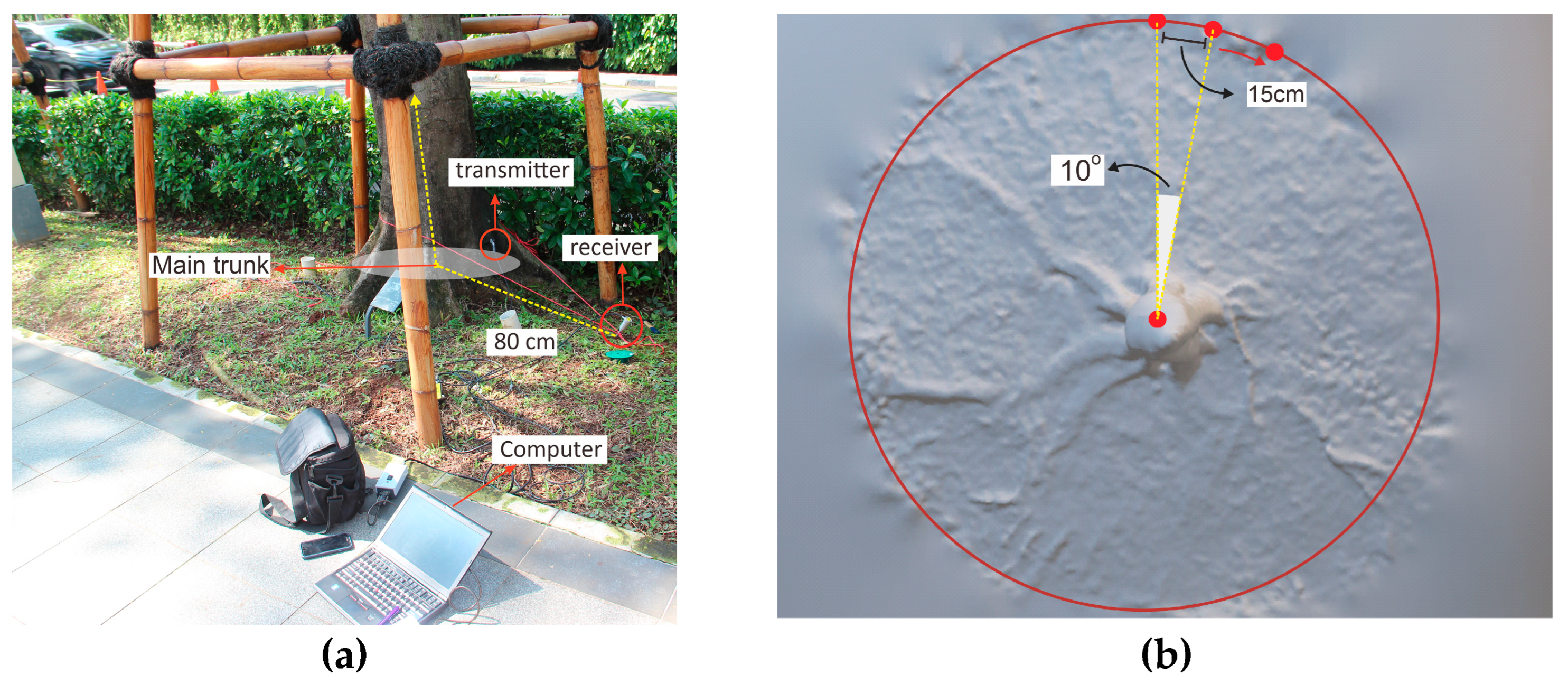
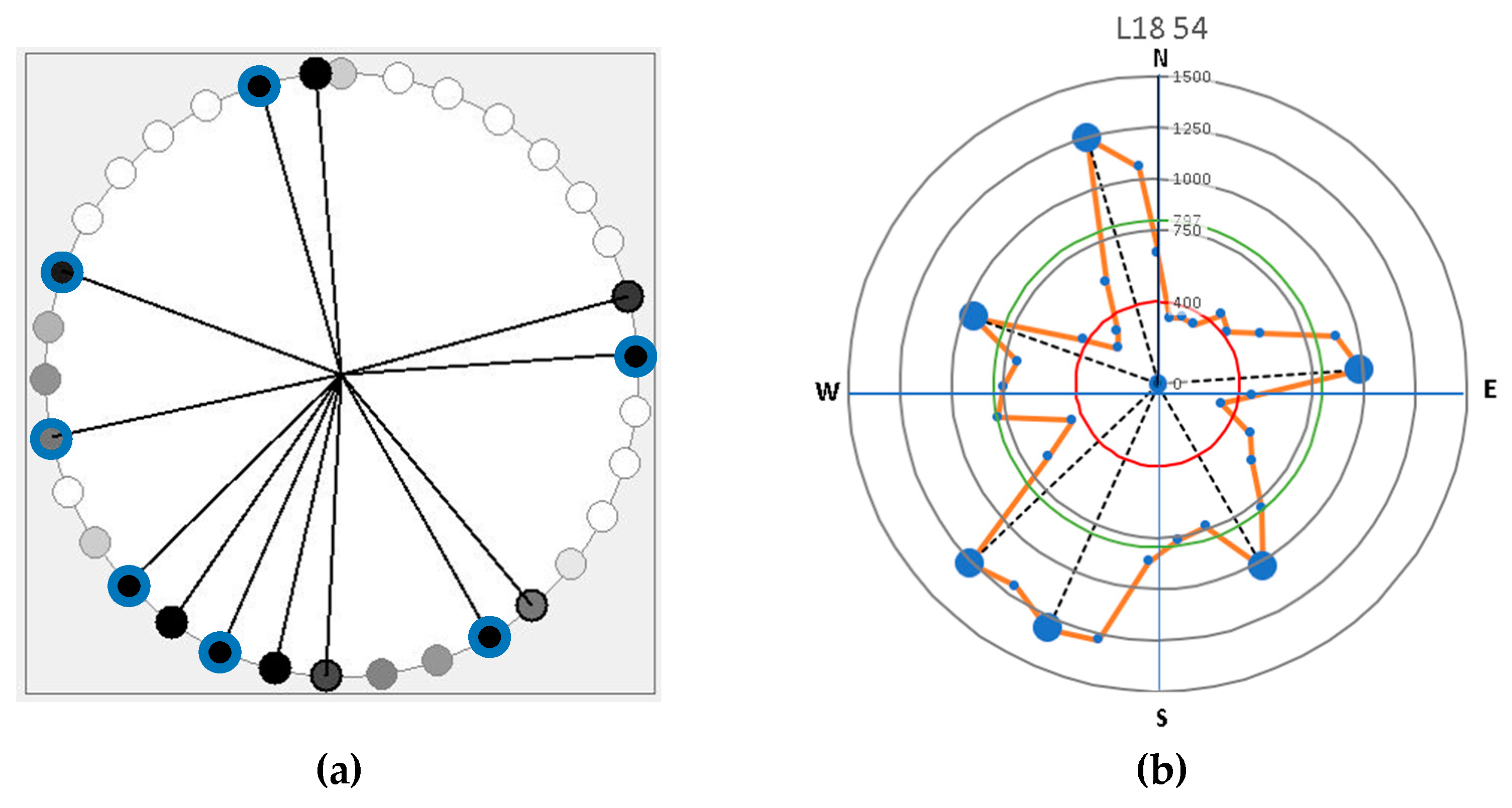
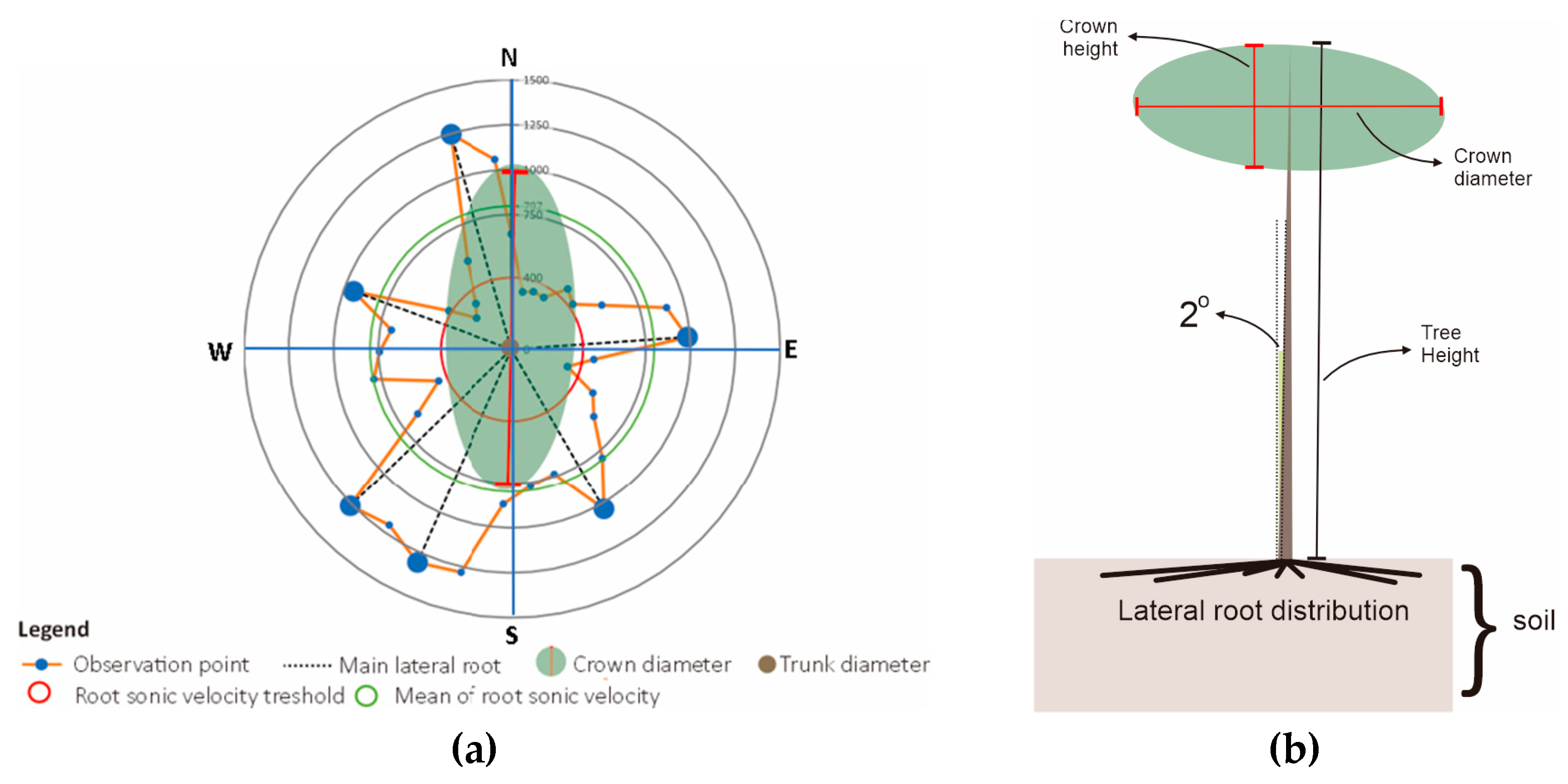
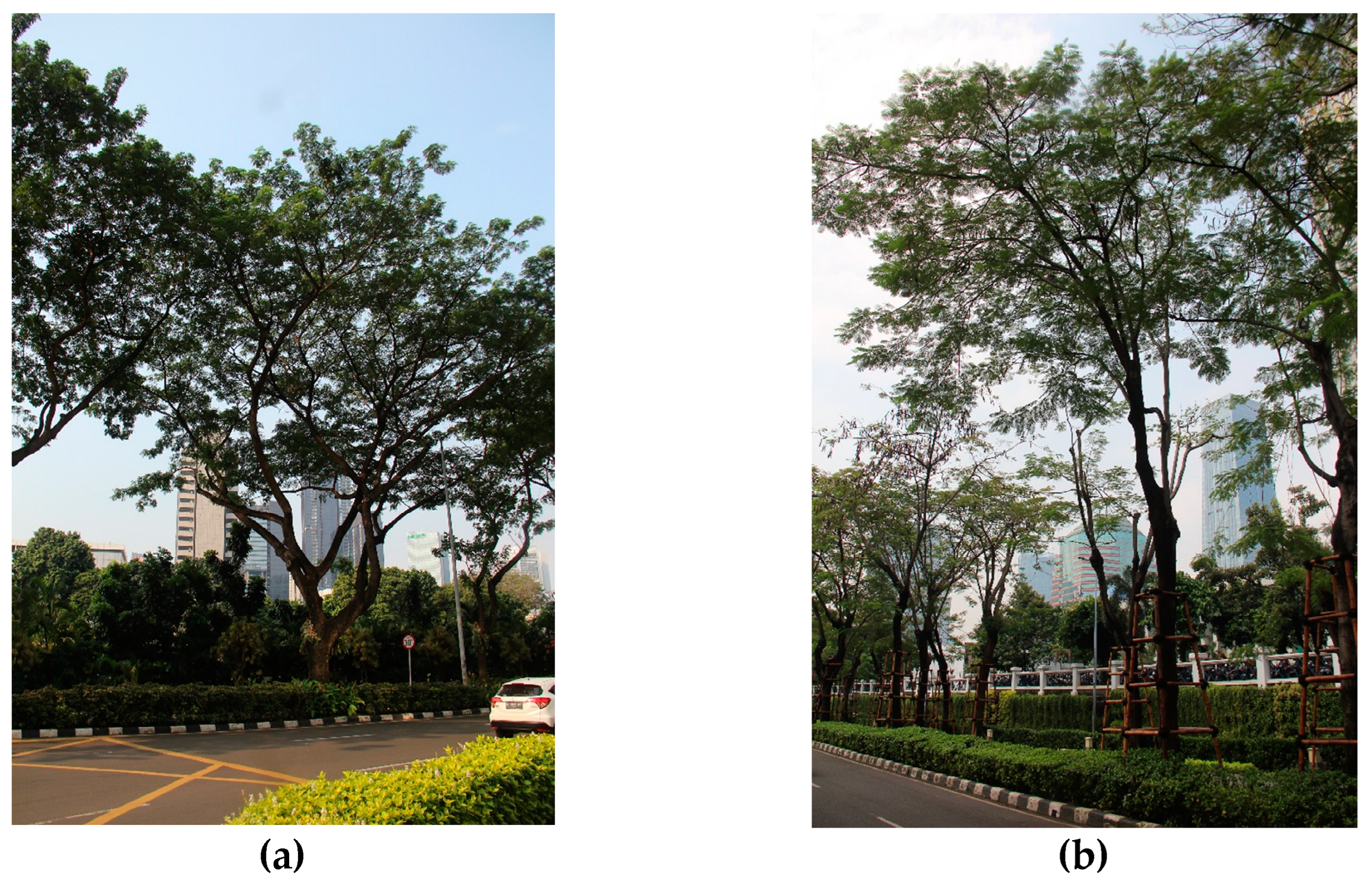
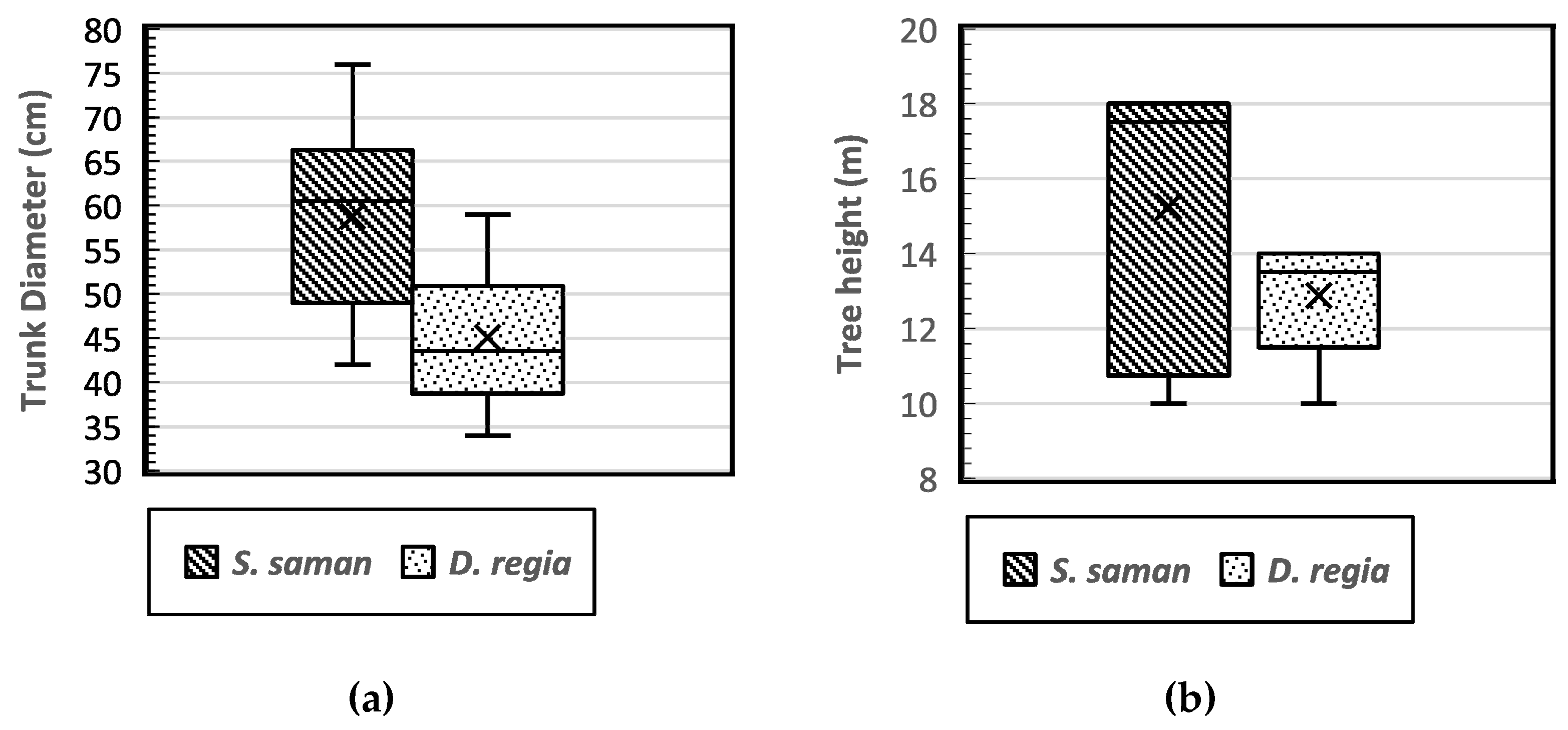




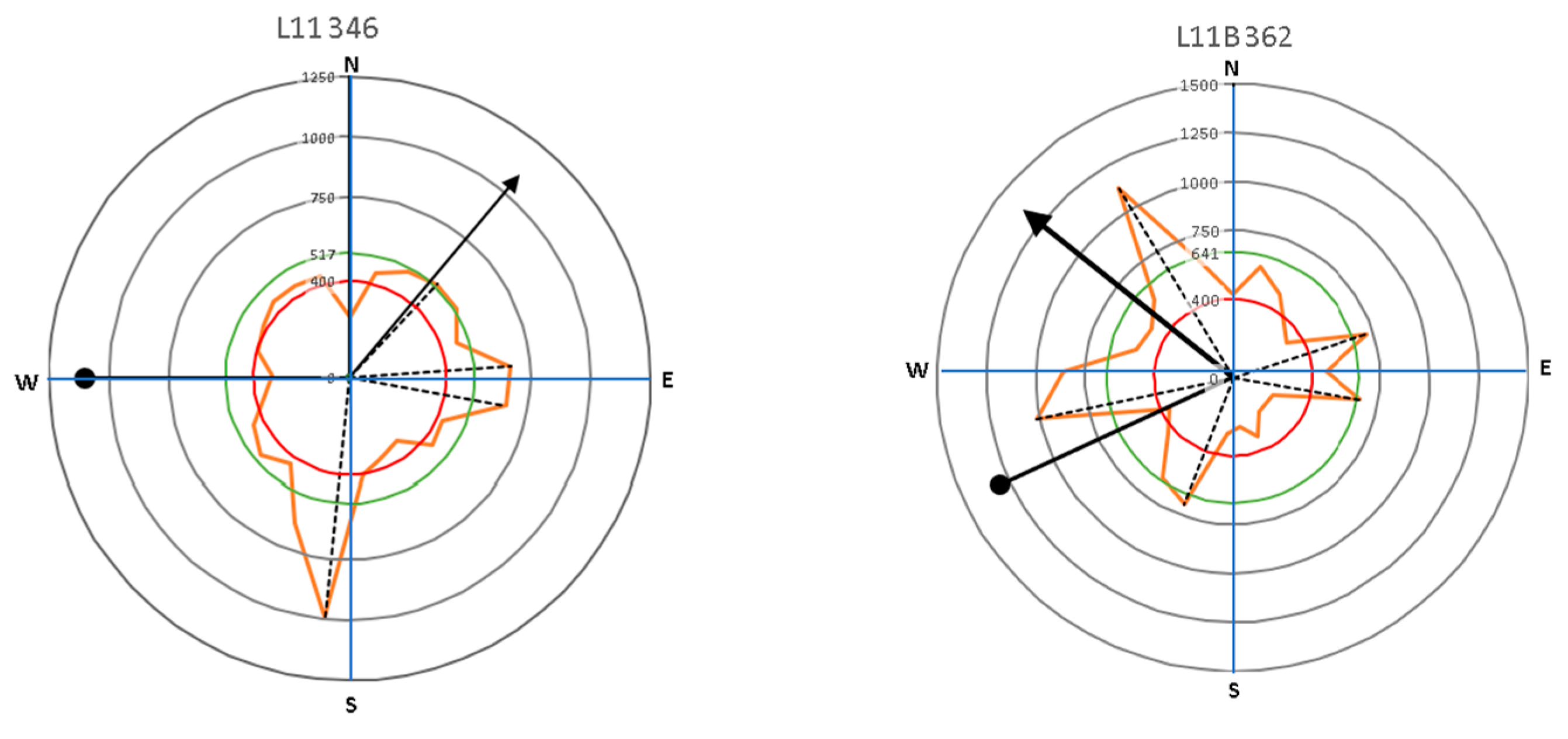
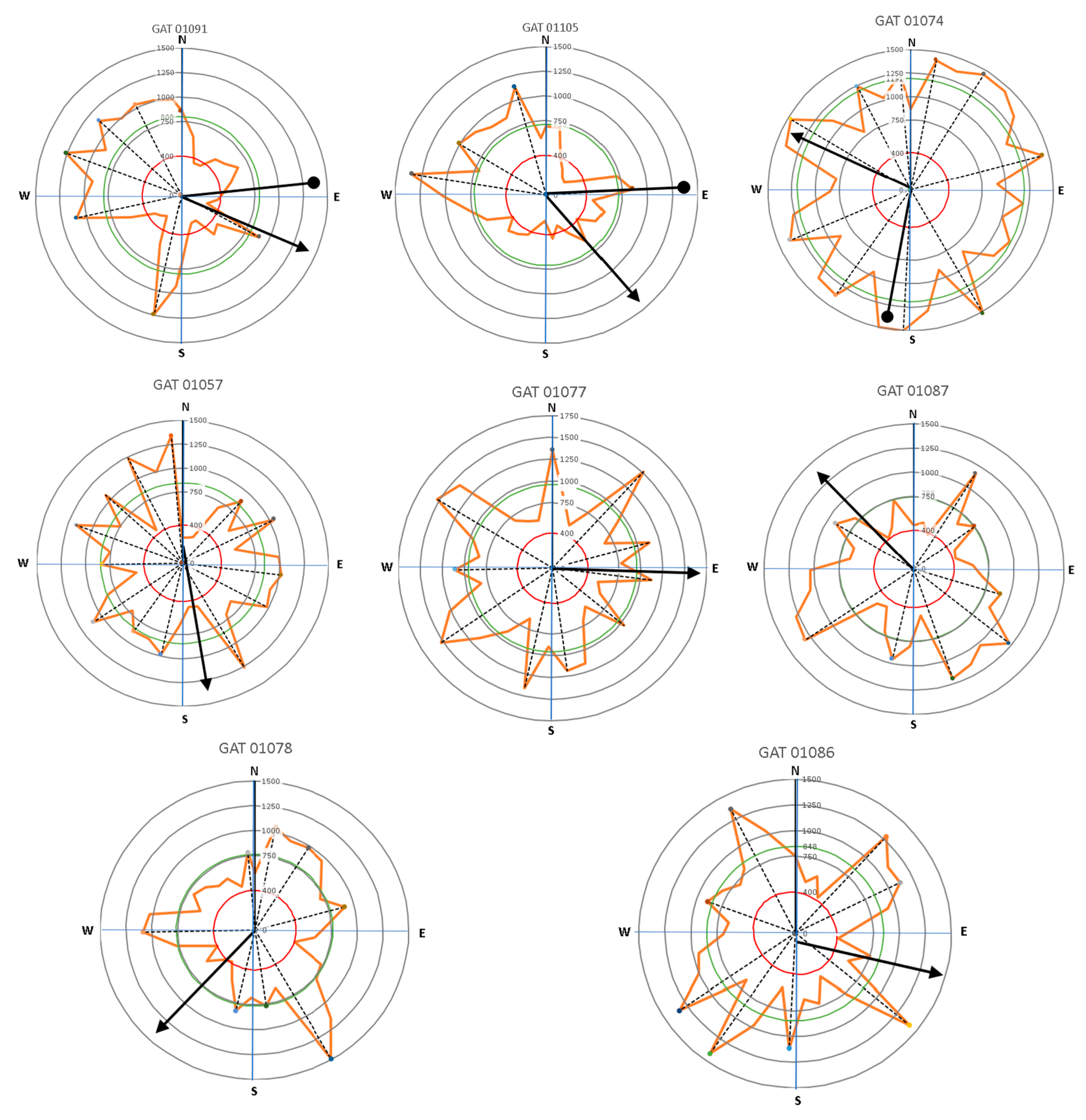

| Parameters | Trunk Diameter | Tree Height | Slenderness Coefficient | Crown Diameter | Tree Leaning Degree | Tree Root Sonic Velocity |
|---|---|---|---|---|---|---|
| Trunk diameter | 1 | |||||
| Tree height | 0.702 ** | 1 | ||||
| Slenderness coefficient | −0.689 ** | −0.157 | 1 | |||
| Crown diameter | 0.154 | 0.492 | 0.039 | 1 | ||
| Tree leaning degree | 0.661 ** | 0.545 * | −0.629 ** | 0.058 | 1 | |
| Tree root sonic velocity | −0.588 * | −0.726 ** | 0.389 | −0.016 | −0.747 ** | 1 |
| No | Species (Tree Code) | Tree Growth Direction | ||
|---|---|---|---|---|
| Tree Lean (Magnitude) | Crown Direction | Root Distribution | ||
| 1 | Samanea saman (L18 53 80) | S (11°) | NE | NW |
| 2 | Samanea saman (L18 54 80) | E (2°) | N | SW |
| 3 | Samanea saman (L18 55) | SE (8°) | SE | NW & NE |
| 4 | Samanea saman (L18 56) | NE (10°) | SW | SW |
| 5 | Samanea saman (L18 57) | NW (20°) | W | SE & SW |
| 6 | Samanea saman (L18 58) | NE (15°) | NE | NE & NW |
| 7 | Samanea saman (L11 346) | W (25°) | NW | S |
| 8 | Samanea saman (L11B 362) | SW (17°) | NW | Distributed |
| 9 | Delonix regia (GAT 01091) | E (8°) | SE | NW |
| 10 | Delonix regia (GAT 01105) | E (10°) | SE | NW |
| 11 | Delonix regia (GAT 01074) | S (9°) | NW | Distributed |
| 12 | Delonix regia (GAT 01057) | Straight (0°) | S | Distributed |
| 13 | Delonix regia (GAT 01077) | Straight (0°) | E | Distributed |
| 14 | Delonix regia (GAT 01087) | Straight (0°) | NW | Distributed |
| 15 | Delonix regia (GAT 01078) | Straight (0°) | SW | Distributed |
| 16 | Delonix regia (GAT 01086) | Straight (0°) | SE | Distributed |
Disclaimer/Publisher’s Note: The statements, opinions and data contained in all publications are solely those of the individual author(s) and contributor(s) and not of MDPI and/or the editor(s). MDPI and/or the editor(s) disclaim responsibility for any injury to people or property resulting from any ideas, methods, instructions or products referred to in the content. |
© 2023 by the authors. Licensee MDPI, Basel, Switzerland. This article is an open access article distributed under the terms and conditions of the Creative Commons Attribution (CC BY) license (https://creativecommons.org/licenses/by/4.0/).
Share and Cite
Rahman, M.M.; Fredisa, Y.; Nandika, D.; Nugroho, N.; Siregar, I.Z.; Karlinasari, L. Inferring Vertical Tree Growth Direction of Samanea saman and Delonix regia Trees with the Pattern of Lateral Root Distribution Using the Root Detector. Forests 2023, 14, 427. https://doi.org/10.3390/f14020427
Rahman MM, Fredisa Y, Nandika D, Nugroho N, Siregar IZ, Karlinasari L. Inferring Vertical Tree Growth Direction of Samanea saman and Delonix regia Trees with the Pattern of Lateral Root Distribution Using the Root Detector. Forests. 2023; 14(2):427. https://doi.org/10.3390/f14020427
Chicago/Turabian StyleRahman, Mohamad Miftah, Yoga Fredisa, Dodi Nandika, Naresworo Nugroho, Iskandar Zulkanaen Siregar, and Lina Karlinasari. 2023. "Inferring Vertical Tree Growth Direction of Samanea saman and Delonix regia Trees with the Pattern of Lateral Root Distribution Using the Root Detector" Forests 14, no. 2: 427. https://doi.org/10.3390/f14020427
APA StyleRahman, M. M., Fredisa, Y., Nandika, D., Nugroho, N., Siregar, I. Z., & Karlinasari, L. (2023). Inferring Vertical Tree Growth Direction of Samanea saman and Delonix regia Trees with the Pattern of Lateral Root Distribution Using the Root Detector. Forests, 14(2), 427. https://doi.org/10.3390/f14020427









